Hitachi P50H401A, P55H401, P42H4011, P50H401, P42H401 User Manual

PLASMA TELEVISION
Operating Guide for P42H401, P42H401A
P50H401, P50H401A, P55H401, P42H4011
P42H4011A, P50H4011, P50H4011A and P55H4011
IMPORTANT SAFETY INSTRUCTIONS .................................................................................................................. |
2-3 |
FIRST TIME USE .................................................................................................................................................... |
4-22 |
THE REMOTE CONTROL ..................................................................................................................................... |
23-31 |
ON-SCREEN DISPLAY ......................................................................................................................................... |
32-54 |
USEFUL INFORMATION ...................................................................................................................................... |
55-64 |
OPERATING GUIDE IN SPANISH ...................................................................................................................... |
65-128 |
END USER LICENSE AGREEMENT FOR HITACHI DTV SOFTWARE .......................................................... |
129-137 |
APPENDIXES ................................................................................................................................................... |
138-139 |
INDEX ....................................................................................................................................................................... |
140 |
SPANISH
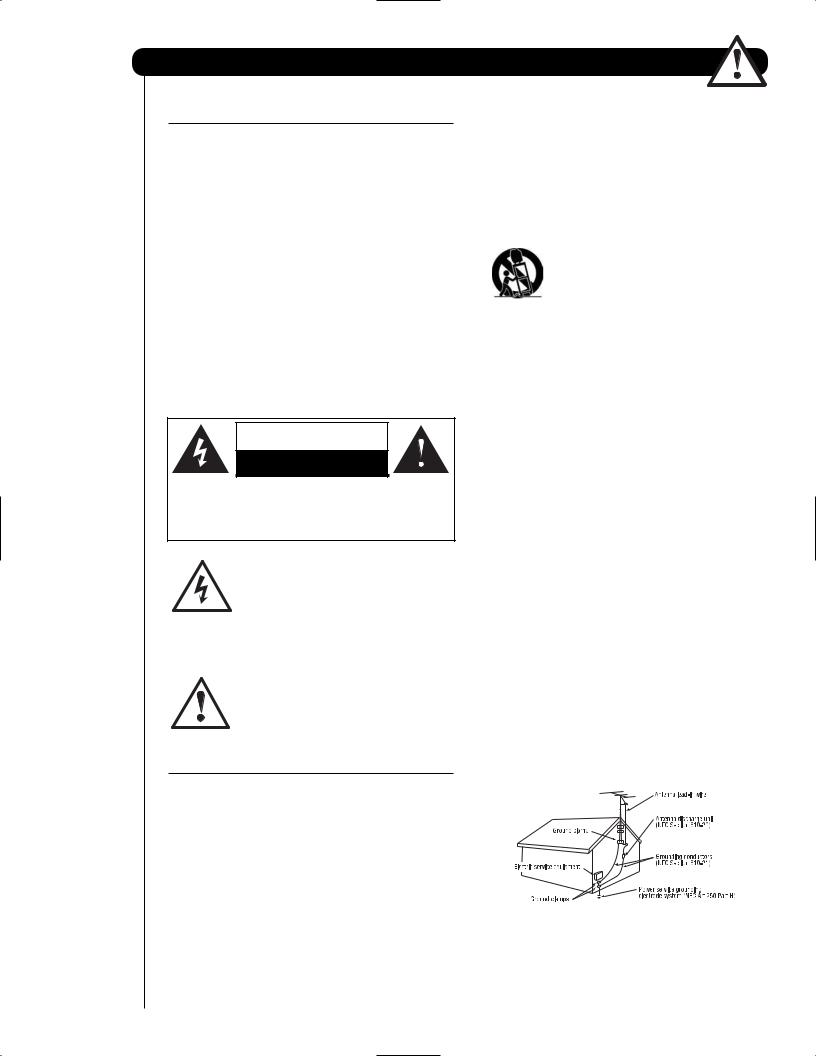
Important Safety Instructions
SAFETY POINTS YOU SHOULD KNOW ABOUT YOUR HITACHI PLASMA TELEVISION
Our reputation has been built on the quality, performance, and ease of service of HITACHI plasma televisions.
Safety is also foremost in our minds in the design of these units. To help you operate these products properly, this section illustrates safety tips which will be of benefit to you. Please read it carefully and apply the knowledge you obtain from it to the proper operation of your HITACHI plasma television.
Please fill out your warranty card and mail it to HITACHI. This will enable HITACHI to notify you promptly in the improbable event that a safety problem should be discovered in your product model.
Follow all warnings and instructions marked on this plasma television.
CAUTION |
RISK OF ELECTRIC SHOCK |
DO NOT OPEN |
CAUTION: TO REDUCE THE RISK OF ELECTRIC SHOCK, |
DO NOT REMOVE COVER (OR BACK). |
NO USER SERVICEABLE PARTS INSIDE. |
REFER SERVICING TO QUALIFIED SERVICE PERSONNEL. |
The lightning flash with arrowhead symbol,
within an equilateral triangle, is intended to alert the user to the presence of
uninsulated “dangerous voltage” within the product’s enclosure that may be of a sufficient magnitude to constitute a risk of electric shock to a person.
The exclamation point within an equilateral triangle, is intended to alert the user to the presence of important operating and maintenance (servicing) instructions in the
literature accompanying the appliance.
READ BEFORE OPERATING EQUIPMENT
Follow all warnings and instructions marked on this plasma television.
1.Read these instructions.
2.Keep these instructions.
3.Heed all warnings.
4.Follow all instructions.
5.Do not use this apparatus near water.
6.Clean only with a dry cloth.
7.Do not block any ventilation openings. Install in accordance with the manufacturer’s instructions.
8.Do not install near any heat sources such as radiators, heat registers, stoves, or other apparatus (including amplifiers) that produce heat.
9.Do not defeat the safety purpose of the polarized or grounding-type plug. A polarized plug has two
blades with one wider than the other. A grounding
2type plug has two blades and a third grounding
prong. The wide blade or the third prong are provided for your safety. If the provided plug does not fit into your outlet, consult an electrician for replacement of the obsolete outlet.
10.Protect the power cord from being walked on or pinched particularly at plugs, convenience receptacles, and the point where they exit from the apparatus.
11.Only use the attachments/accessories specified by the manufacturer.
12.Use only with the cart, stand, tripod, bracket, or table specified by the
manufacturer, or sold with the apparatus. When a cart is used, use caution when moving the cart/apparatus
combination to avoid injury from tip-over.
13.Unplug this apparatus during lightning storms or when unused for long periods of time.
14.Refer all servicing to qualified service personnel. Servicing is required when the apparatus has been damaged in any way, such as power-supply cord or plug is damaged, liquid has been spilled or objects have fallen into apparatus, the apparatus has been exposed to rain or moisture, does not operate normally, or has been dropped.
15.Televisions are designed to comply with the recommended safety standards for tilt and stability. Do not apply excessive pulling force to the front, or top, of the cabinet which could cause the product to overturn resulting in product damage and/or personal injury.
16.Follow instructions for wall, shelf or ceiling mounting as recommended by the manufacturer.
17.An outdoor antenna should not be located in the vicinity of overhead power lines or other electrical circuits.
18.If an outside antenna is connected to the receiver be sure the antenna system is grounded so as to provide some protection against voltage surges and built up static charges. Section 810 of the National Electric Code, ANSI/NFPA No. 70-1984, provides information with respect to proper grounding for the mast and supporting structure, grounding of the
lead-in wire to an antenna discharge unit, size of grounding connectors, location of antenna discharge unit, connection to grounding electrodes and
requirements for the grounding electrode.
NEC National Electric Code
Note to the CATV system installer: This reminder is provided to call the CATV system installer’s attention to Article 820-44 of the NEC that provides guidelines for proper grounding and, in particular, specifies that the cable ground shall be connected to the grounding system of the building, as close to the point of cable entry as practical.
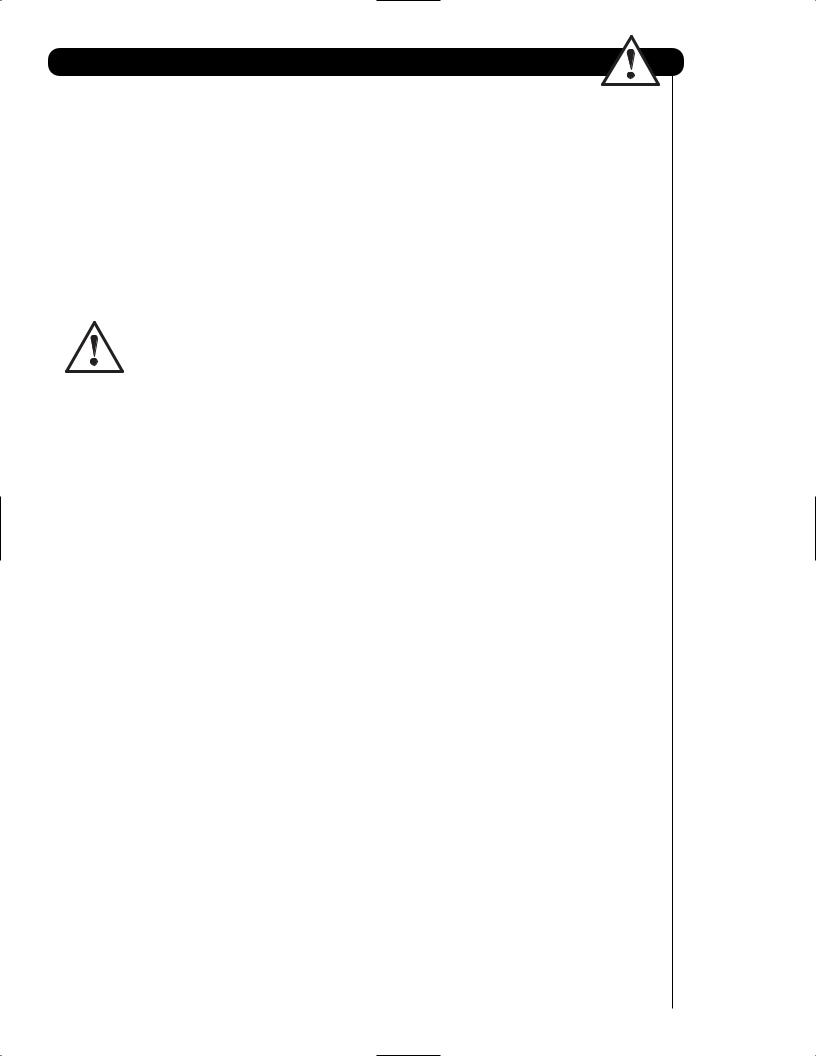
Important Safety Instructions
Power source
This plasma television is designed to operate on 120 volts 60 Hz, AC current. Insert the power cord into a 120 volt 60 Hz outlet. The mains plug is used as the disconnect device and shall remain readily operable.
To prevent electric shock, do not use the plasma television’s (polarized) plug with an extension cord, receptacle, or other outlet unless the blades and ground terminal can be fully inserted to prevent blade exposure.
Never connect the plasma television to 50 Hz, direct current, or anything other than the specified voltage.
Caution
Never remove the back cover of the plasma television as this can expose you to very high voltages and other hazards. If the television does not operate properly,
unplug the plasma television and call your authorized dealer or service center.
Caution
Adjust only those controls that are covered in the instructions, as improper changes or modifications not expressly approved by HITACHI could void the user’s warranty.
Warning
•To reduce the risk of fire or electric shock, do not expose this apparatus to rain or moisture.
•The plasma television should not be exposed to dripping or splashing and objects filled with liquids, such as vases, should not be placed on the television.
•This apparatus shall be connected to a mains socket outlet with a protective earthing connection.
Public viewing of copyrighted material
Public viewing of programs broadcast by TV stations and cable companies, as well as programs from other sources, may require prior authorization from the broadcaster or owner of the video program material.
This product incorporates copyright protection technology that is protected by U.S. patents and other intellectual property rights. Use of this copyright protection technology must be authorized, and is intended for home and other limited consumer uses only unless otherwise authorized. Reverse engineering or disassembly is prohibited.
Note
This digital television is capable of receiving analog basic, digital basic cable television programming by direct connection to a cable system providing such programming. Certain advanced and interactive digital cable services such as video-on-demand, a cable operator’s enhanced program guide and data-enhanced television services may require the use of a set-top box.
For more information call your local cable company.
Note
•There are no user serviceable parts inside the plasma television.
•Model and serial numbers are indicated on back side and right side of the plasma television.
Prevention of screen damages
Continuous on-screen displays such as video games, stock market quotations, computer generated graphics, and other fixed (non-moving) patterns can be permanently imprinted onto your TV screen. Such “SCREEN DAMAGES” constitute misuse and are NOT COVERED by your HITACHI Factory Warranty.
If still images are left on the screen for more than 2.5 minutes, protection function will work automatically so that contrast reduces to minimize image retention on plasma display panel.
Please note that this is not a malfunction but it helps to minimize image retention.
The original contrast will restore after moving images are displayed for about 6 minutes. Original contrast can be restored quickly by turning power Off/On with remote control or power switch on unit.
Lead Notice
This product contains lead. Dispose of this product in
accordance with applicable environmental laws. For product recycling and disposal information, contact your local government agency or www.eRecycle.org (in California), the Electronic Industries Alliance at www.eiae.org (in the US) or the Electronic Product Stewardship Canada at www.epsc.ca (in Canada).
FOR MORE INFORMATION, CALL 1-800-HITACHI.
3
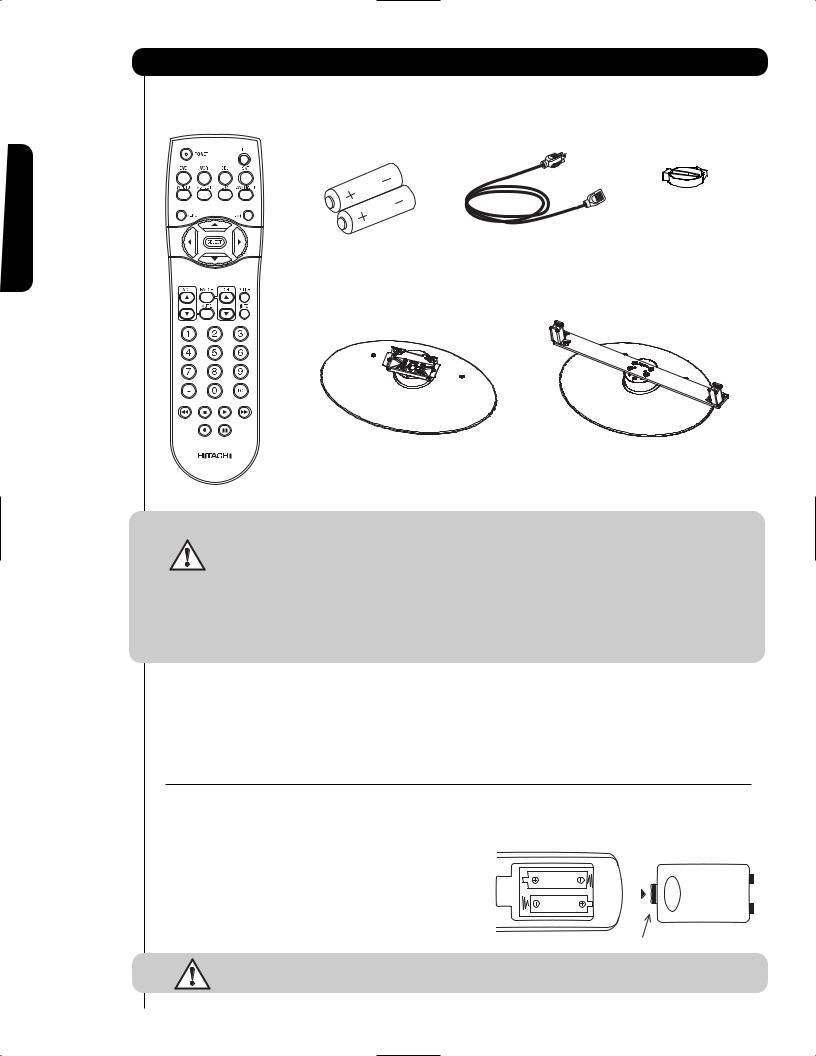
Accessories
Check to make sure you have the following accessories before disposing of the packing material.
Remote Control |
Two “AA” size, |
Power Cord |
Wire Clamp |
|
1.5V batteries |
|
(50" models only) |
First time use
Table Top Stand |
Table Top Stand |
|
(42” included) |
||
(50" included) |
For U.S. models: |
Note: Please visit our |
For optional accessories, please access our web site at: |
website for optional |
www.hitachi.us/tv |
accessories. |
Note : The accessories for models H4011, H4011A series are similar as the H401, H401A series.
CAUTION: 1. Ceiling mounting is not recommended. Mounting the panel on the ceiling does not provide adequate ventilation for the electronics or proper support for the front glass panel. This plasma television product is designed for a maximum tilting angle of 45 degrees from vertical.
2.This stand for use only with Hitachi P42H401, P42H401A, P50H401 and
P50H401A models. The use of other apparatus is capable of resulting in instability causing possible injury.
3. The wall mount unit for the 50" and 42" |
models is WM07S and for the |
55" models is WM07L. Please see page 7 |
for important information related |
to the wall mount. Wall Mount unit is an optional accessory (Not Included). |
|
Remote Control Unit CLU-4371UG2 (Part No HL02075 only H401 series) |
Wire Clamp (50" models only) |
Remote Control Unit CLU-4372UG2 (Part No HL02076 only H4011 series)
Two "AA" size, 1.5V batteries .
Table Top Stand (UX27661 42" model) (UX27281 50" models).
Power Cord (P# EV01841).
REMOTE CONTROL BATTERY INSTALLATION AND REPLACEMENT
1.Open the battery cover of the remote control by pushing down and sliding the back cover off.
2.Insert two new “AA” size batteries for the remote control. When replacing old batteries, push them towards the
springs and lift them out. |
|
3. Match the batteries to the (+) and (-) marks in the battery |
Bottom View (Remote Control) |
compartment. |
|
4.Insert the bottom of the battery, the (-) side, into the battery compartment first, push towards the springs and insert the top of the battery, the (+) side, into place. Do not force the battery into the battery compartment.
5.Replace the cover.
Lift up on tab to remove back cover.
CAUTION: Do not insert batteries with ‘+’ and ‘-’ polarities reversed as this may cause the batteries to swell or rupture resulting in leakage.
4

How To Set Up Your New Hitachi Plasma Television
To take measures to prevent the Plasma Television from tipping over and prevent possible injury it is important to mount the unit in a stable and flat surface.
Securing to a table-top
1.Using wood screws (two) fasten the set to the
clamping screw holes on the rear of the Plasma
TV stand as shown below.
2.Using commercially available wood screws, secure the set firmly in position.
Wire
Wood screw two places
Securing to a Wall
1.Keep the Plasma television 4 inches away from the wall except when mounted using the wall mount bracket.
2.Secure the television to the wall as shown.
A
|
A |
42" |
4 in. |
|
10 cm |
50" |
4 in. |
|
10 cm |
55" |
4 in. |
|
10 cm |
*Please adjust the wire length to avoid touching the wall when turning the TV.
NOTES: 1. Do not block the ventilation holes of the Plasma Television. Blocking the ventilation holes might cause fire or defect.
2.In case of an abnormal symptom, unplug the AC cord.
3.If you purchased the wall mount bracket option, please ask for professional installer. Do not install by yourself.
4.Install the unit at a proper area where it does not expose anyone to any danger of hitting
themselves (for example their hands, head or face, etc.) against the edge of the unit and cause personal injury.
55”
NOTE: The Table Top Stand for model P55H401 and P55H4011 is not included (Optional).
ANTENNA
Unless your Plasma Television is connected to a cable TV system or to a centralized antenna system, a good outdoor color TV antenna is recommended for best performance. However, if you are located in an exceptionally good signal area that is free from interference and multiple image ghosts, an indoor antenna may be sufficient.
LOCATION
Select an area where sunlight or bright indoor illumination will not fall directly on the picture screen. Also, be sure that the location selected allows a free flow of air to and from the perforated back cover of the set. In order to prevent an internal temperature increase, maintain a space of 10 cm (4 inches) from the sides/back of the Television, and 30 cm (12 inches) from the top of the television to the wall. To avoid cabinet warping, cabinet color changes, and increased chance of set failure, do not place the TV where temperatures can become excessively hot, for example, in direct sunlight or near a heating appliance, etc.
Caution when moving the main unit |
|
30 cm (12 inches) |
|
As this product is heavy, whenever it is moved, two |
|
||
|
|
||
people are required to transport it safely. Whenever the |
10 cm (4 inches) |
10 cm (4 inches) |
|
unit is moved it should be lifted forward using the top |
|||
|
|||
|
|
||
and base on both sides of the Television for stability. |
|
|
|
When moving the Television, lift the handles , then |
|
|
|
support the top frame as shown below. |
|
|
42” 50”
use time First
5
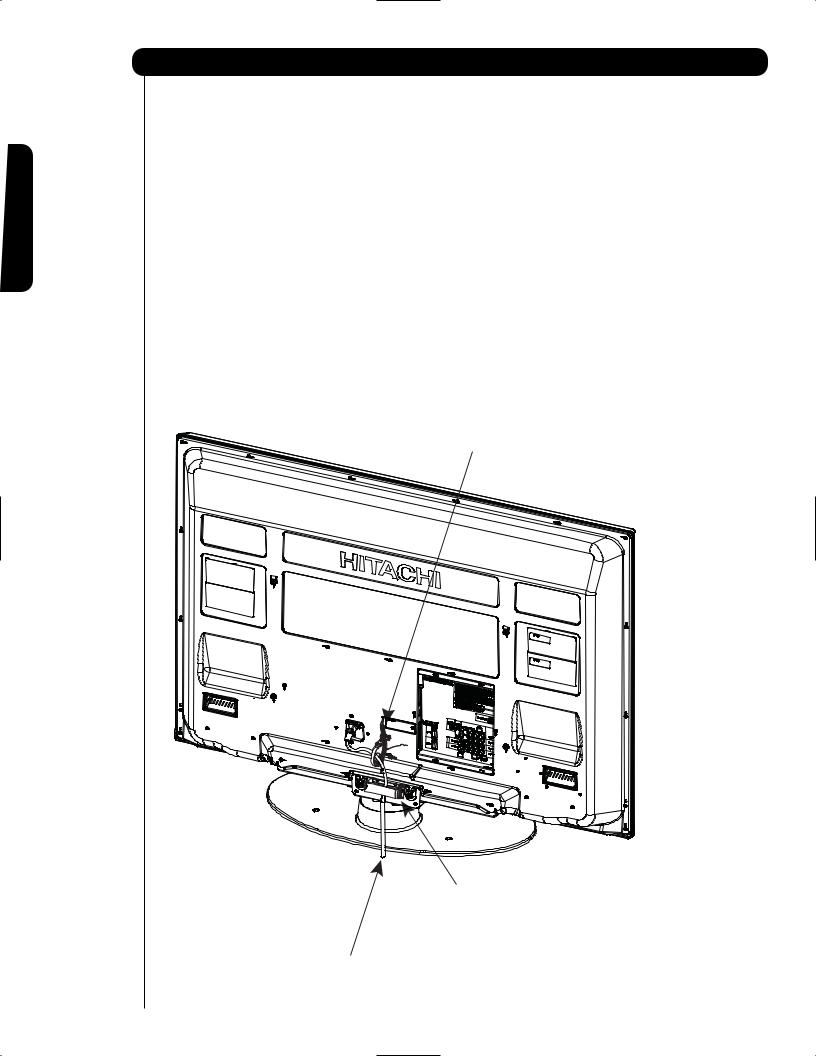
First time use
How to set up your new HITACHI Plasma Television
AC CORD INSTALLATION INSTRUCTION
The AC cord provided with your new Plasma Television needs to be installed correctly to avoid the AC cord from disconnecting when rotating the TV on its Table top stand. Located on the back of the TV are 2 plastic clamps to hold the AC cord. Please follow the instructions below.
Pass the AC cord through Clamp #1 and connect it to the TV. Pull on the clamp to tighten the AC cord to the TV.
The AC cord and the signal cables can all be held together with Clamp #2.
Depend on the model size 42",50" or 55", the clamp may be different shapes. Only for 50" models the clamp #2 will be included on the accessories bag.
Clamp #1 : Pass the AC cord through this clamp ; then pull the clamp to tighten the AC cord to the TV.
Clamp #2: Use this clamp to hold the AC cord and the signal cables. For 50 " model please assemble this Clamp on the middle hole
of the base metal.
AC CORD
6
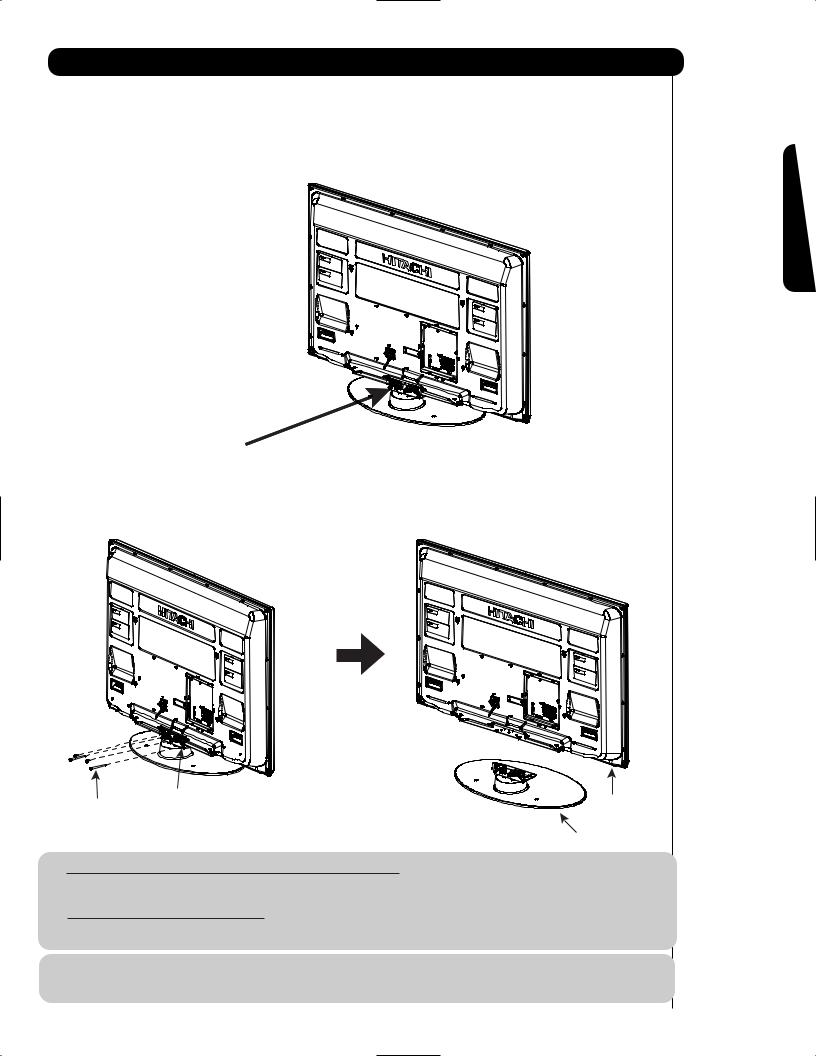
How to set up your new HITACHI Plasma Television
SETTING FOR WALL MOUNTING ON 50" & 55" MODELS
STEP (1) :
Please locate the STAND METAL on the back of the TV . This metal is use to hold the TV and the Base ; so it needs to remove 4 screws from the STAND base in order to separate the TV from the Base.
STAND METAL
STEP (2):
Please remove the 4 screws of the STAND metal from the TV, now the TV STAND can be separated from the TV. For dimensions of the WALL MOUNT assembly please refer to page 61 & 62.
STAND METAL
4 SCREWS
TV STAND BASE
For Model P50H401, P50H401A, P50H4011 and P50H4011A
CAUTION- This Plasma Display Panel for use only with Hitachi WM07S Wall Mount. Use with other Wall Mount is capable of resulting in instability causing possible injury.
For Model P55H401 and P55H4011
CAUTION- This Plasma Display Panel for use only with Hitachi WM07L Wall Mount. Use with other Wall Mount is capable of resulting in instability causing possible injury.
NOTE: Use the specified WALL MOUNT unit for the Plasma TV depending on the size of your TV. Please access our web site at: www.hitachi.us/tv for recommended accessories for your tv.
use time First
7
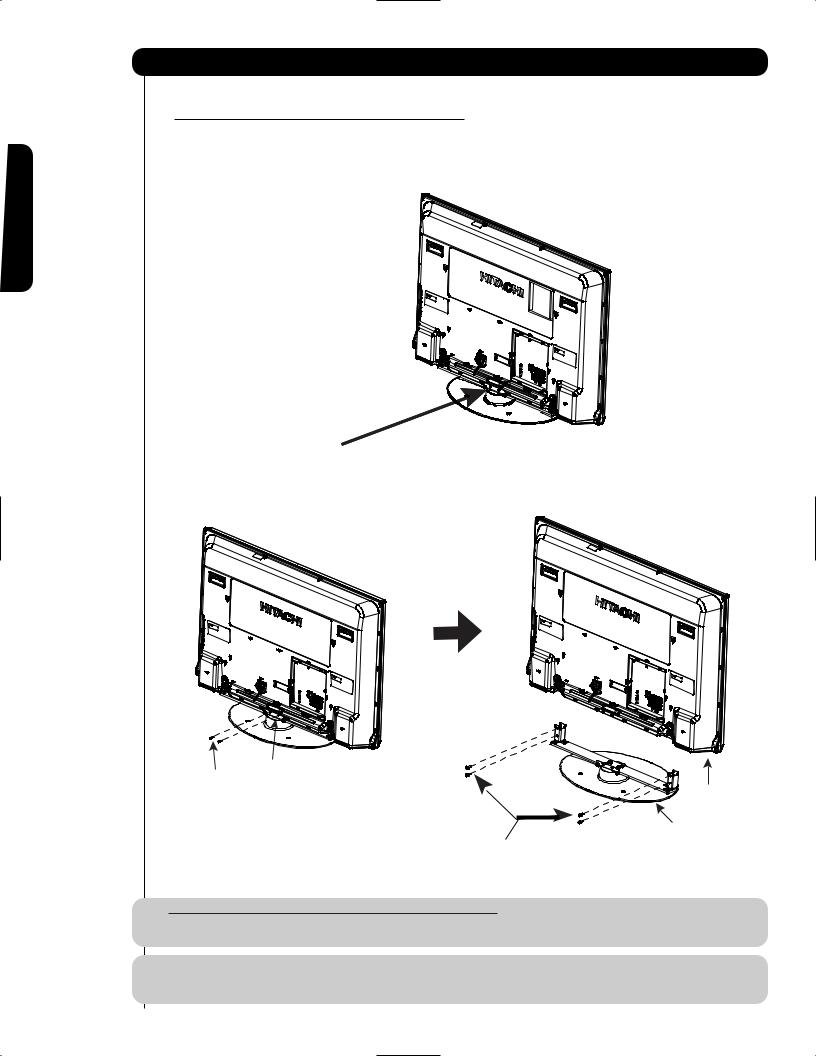
First time use
How to set up your new HITACHI Plasma Television
SETTING FOR WALL MOUNTING ON 42" MODELS
STEP (1) :
Please locate the STAND METAL on the back of the TV . This metal is use to hold the TV and the Base ; so it needs to remove 6 screws from the STAND base in order to separate the TV from the Base.
STAND METAL
STEP (2):
Please remove the 2 screws of the STAND metal from the TV, then remove 4 screws that hold the TV STAND BASE; now the TV STAND can be separated from the TV.For dimensions of the WALL MOUNT assembly please refer to page 60.
STAND METAL
2 SCREWS
Remove these 2 screws
first to separate the TV |
TV STAND BASE |
|
from the stand metal. |
||
Remove these 4 screws |
||
Then put these 2 screws |
||
to separate the TV from |
||
back to the TV. |
||
the stand base. |
||
|
For Model P42H401, P42H401A, P42H4011 and P42H4011A
CAUTION- This Plasma Display Panel for use only with Hitachi WM07S Wall Mount. Use with other Wall Mount is capable of resulting in instability causing possible injury.
NOTE: Use the specified WALL MOUNT base for the Plasma TV depending on the size of your TV. Please access our web site at: www.hitachi.us/tv for recommended accessories for your tv.
8

How to set up your new HITACHI Plasma Television
VIEWING
The best picture is seen by sitting directly in front of the TV and about 10 to 18 feet from the screen.
During daylight hours, reflections from outside light may appear on the screen. If so, drapes or screens can be used to reduce the reflection or the TV can be located in a different section of the room.
If the TV’s audio output will be connected to a Hi-Fi system’s external speakers, the best audio performance will be obtained by placing the speakers equidistant from each side of the receiver cabinet and as close as possible to the height of the picture screen center. For best stereo separation, place the external speakers at least four feet from the side of the TV, place the surround speakers to the side or behind the viewing area.
Differences in room sizes and acoustical environments will require some experimentation with speaker placement for best performance.
R |
|
|
|
S |
|
|
|
|
|
4" Minimum |
80 |
BEST |
|
|
|
|
HORIZONTAL |
|
|
5' |
|
10' |
15' |
20' |
|
80 |
VIEWING ANGLE |
|
|
4" Minimum |
|
|
|
|
|
|
|
|
|
L |
|
|
|
S |
ANTENNA CONNECTIONS TO REAR JACK
PANEL
VHF (75-Ohm) antenna/CATV (Cable TV)
When using a 75-Ohm coaxial cable system, connect CATV coaxial cable to the AIR/CABLE (75-Ohm) terminal. Or if you have an antenna, connect the coaxial cable to the same AIR/CABLE terminal.
|
|
AIR / CABLE |
To CATV cable |
VHF (300-Ohm) antenna/UHF antenna |
|
|
|
|
|
|
|
When using a 300-Ohm twin lead from an outdoor |
|
|
|
antenna, connect the VHF or UHF antenna leads to |
To outdoor antenna |
or |
|
screws of the VHF or UHF adapter. Plug the adapter |
|
|
|
|
|
|
|
into the antenna terminal on the TV. |
|
|
|
|
|
AIR / CABLE |
|
When both VHF and UHF antennas are |
|
|
To outdoor VHF |
connected |
|
|
|
|
|
or UHF antenna |
|
Attach an optional antenna cable mixer to the TV |
|
|
|
|
|
|
|
antenna terminal, and connect the cables to the |
To UHF |
|
To outdoor antenna |
antenna mixer. Consult your dealer or service store for |
AIR / CABLE |
||
the antenna mixer. |
antenna |
|
or CATV system |
|
|
|
Antenna Mixer
NOTE: Connecting a 300-Ohm twin lead connector may cause interference. Using a 75-Ohm coaxial cable is recommended.
use time First
9
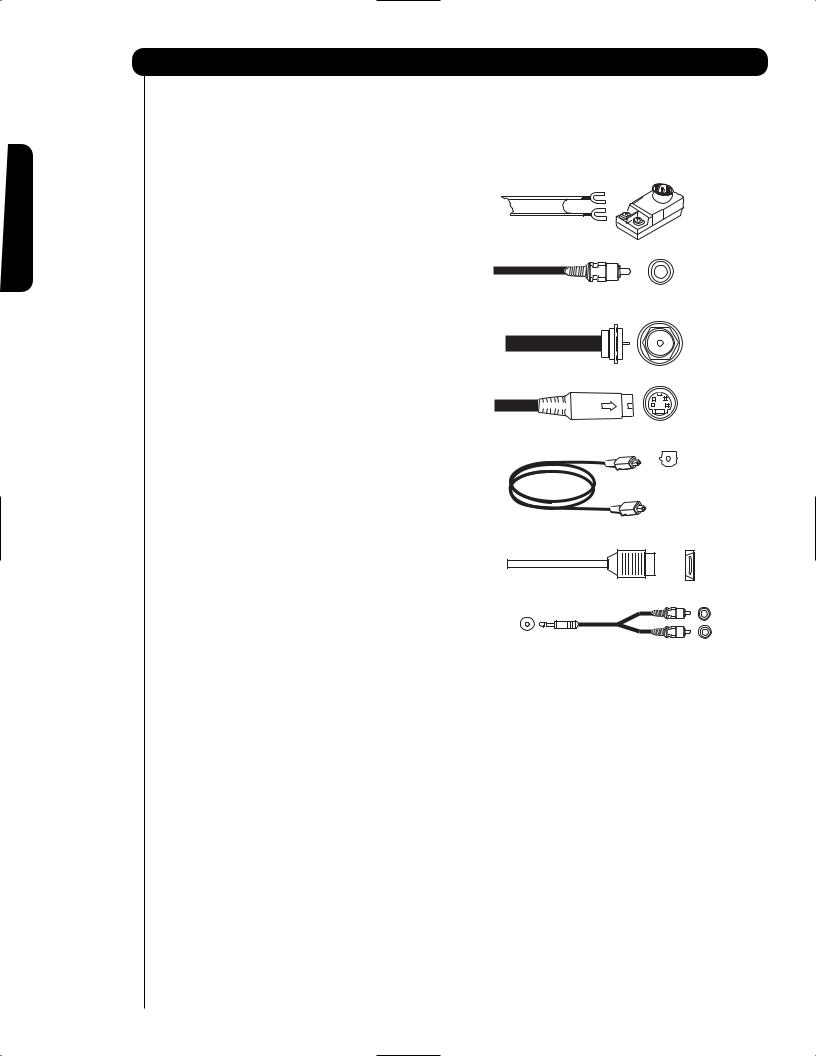
First time use
Hook-up Cables and Connectors
Most video/audio connections between components can be made with shielded video and audio cables that have phono connectors. For best performance, video cables should use 75-Ohm coaxial shielded wire. Cables can be purchased from most stores that sell audio/video products. Below are illustrations and names of common connectors. Before purchasing any cables, be sure of the output and input connector types required by the various components and the length of each cable.
300-Ohm Twin Lead Cable
This outdoor antenna cable must be connected to an antenna adapter (300-Ohm to 75-Ohm).
Phono or RCA Cable
Used on all standard video and audio cables which
connect to inputs and outputs located on the television’s rear jack panel and front control panel.
“F” Type 75-Ohm Coaxial Antenna
For connecting RF signals (antenna or cable TV) to the antenna jack on the television.
S-Video (Super Video) Cable
This connector is used on camcorders, VCRs and laserdisc players with an S-Video feature in place of the standard video cable to produce a high quality picture.
Optical Cable
This cable is used to connect to an audio amplifier with an Optical Audio In jack. Use this cable for the best sound quality.
HDMI Cable
This cable is used to connect your external devices such as Set-Top-Boxes or DVD players equipped with an HDMI output connection to the TV’s HDMI input.
Stereo Cable (3.8mm plug to 3.5mm plug)
Used on all standard video and audio cable which
connect to inputs and outputs located on the rear jack panel and front control panel.
AUDIO OUT |
2 |
3.8mm |
|
STEREO |
RCA TYPE |
MINI-PLUG |
PLUGS |
10
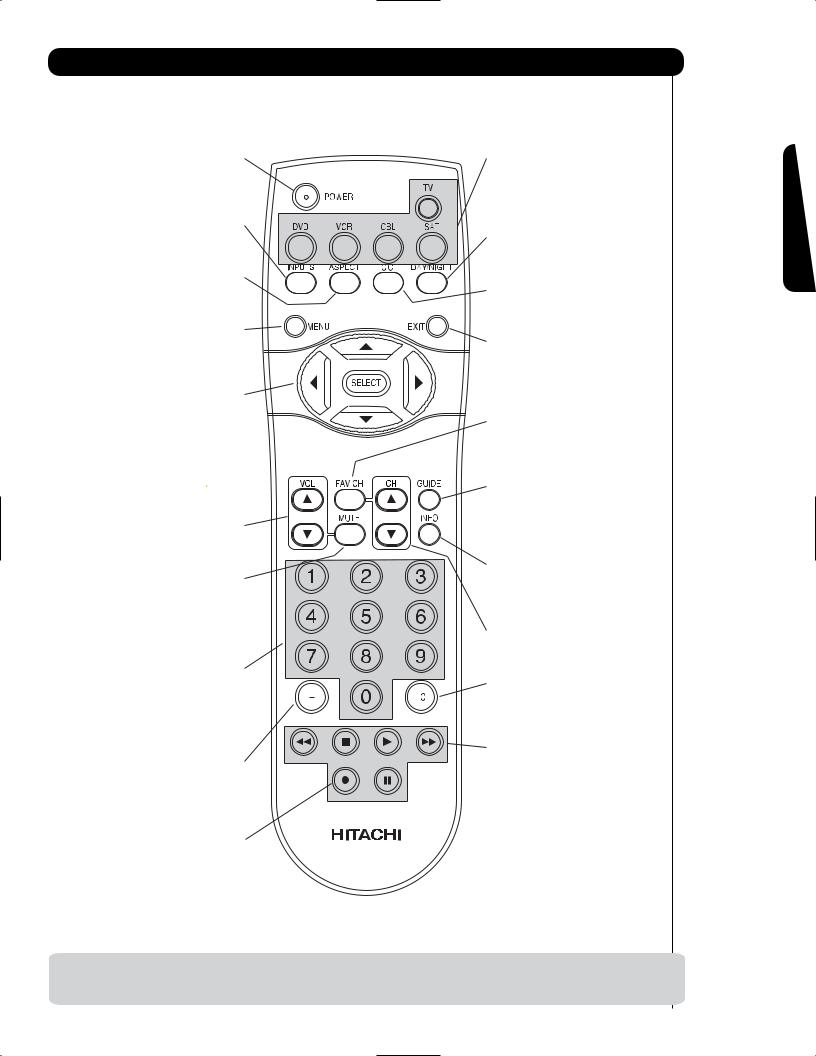
Quick Reference Remote Control Buttons and Functions
In addition to controlling all of the functions on your HITACHI Plasma TV, the new remote control is
designed to operate different types of devices, such as, DVD Players, CBL (Cable Boxes), set-top-boxes, satellite receivers, and VCRs. The remote control must be programmed to control the chosen device. Please see pages 2331 for a complete description of all features and programming of the Remote Control.
POWER BUTTON (TV, CBL, VCR, DVD, SAT)
Turns the selected device on and off.
INPUTS BUTTON (TV)
Accesses the INPUTS menu system.
ASPECT BUTTON (TV)
Changes the aspect ratio while watching TV.
MENU BUTTON (CBL, DVD, SAT, TV)
Accesses the OSD menu system.
CURSOR/SELECT BUTTONS (TV, DVD, CBL, SAT)
The CURSOR buttons are used to navigate the cursor through the OSD and INPUTS menu systems, and the SELECT button is used to Select/Activate the highlighted menu item.
VOLUME BUTTONS (TV)
Adjusts the audio level of your TV.
MUTE BUTTON (TV)
Reduces the audio level to 50% if pressed once, and to complete mute if pressed twice. Press it a third time to restore audio level.
NUMERIC BUTTONS (TV, DVD, CBL, SAT, VCR)
Used to manually enter the TV channel, and used for numeric entry when navigating through the OSD menu system.
(-) BUTTON (TV, SAT)
The (-) button is used when the remote is in Set-Top-Box (STB) mode or when the TV uses a digital input.
RECORD BUTTON (VCR)
Press twice (2 times) to record programs.
SOURCE ACCESS BUTTONS (TV, DVD, VCR, CBL, SAT)
Changes the mode of the Universal Remote Control to control the device selected.
DAY/NIGHT BUTTON (TV)
Select picture mode settings between DAY and NIGHT mode.
CC BUTTON (TV)
Press to show and change the Closed Caption mode.
EXIT BUTTON
(TV, CBL, SAT)
Exits out of the OSD or INPUTS menu systems if their menu is displayed.
FAVORITE CHANNEL (FAV CH) button (TV)
Press to enter/access Favorite Channel (FAV) mode.
GUIDE BUTTON
(SAT/STB, CBL)
Accesses the program guide of other devices.
INFO BUTTON
(TV, CBL, SAT)
Displays various information on the screen.
CHANNEL BUTTONS (TV, CBL, SAT, VCR)
Changes the channel.
LAST CHANNEL (LC) BUTTON (TV, CBL, SAT)
Switches between the current and last channel viewed.
DVD/VCR CONTROL
BUTTONS (DVD, VCR)
Controls the precode functions of your VCR and DVD.
LEGEND |
|
TV— Television |
VCR — Video Cassette Recorder/Player SAT — Satellite Receiver |
CBL — Cable Box |
DVD — Digital Video Disc Player |
NOTES: 1. The TV’s remote control sensor is located on the right bottom portion of the TV screen. To control TV functions, please point the remote control directly at the remote control sensor for best results.
use time First
11
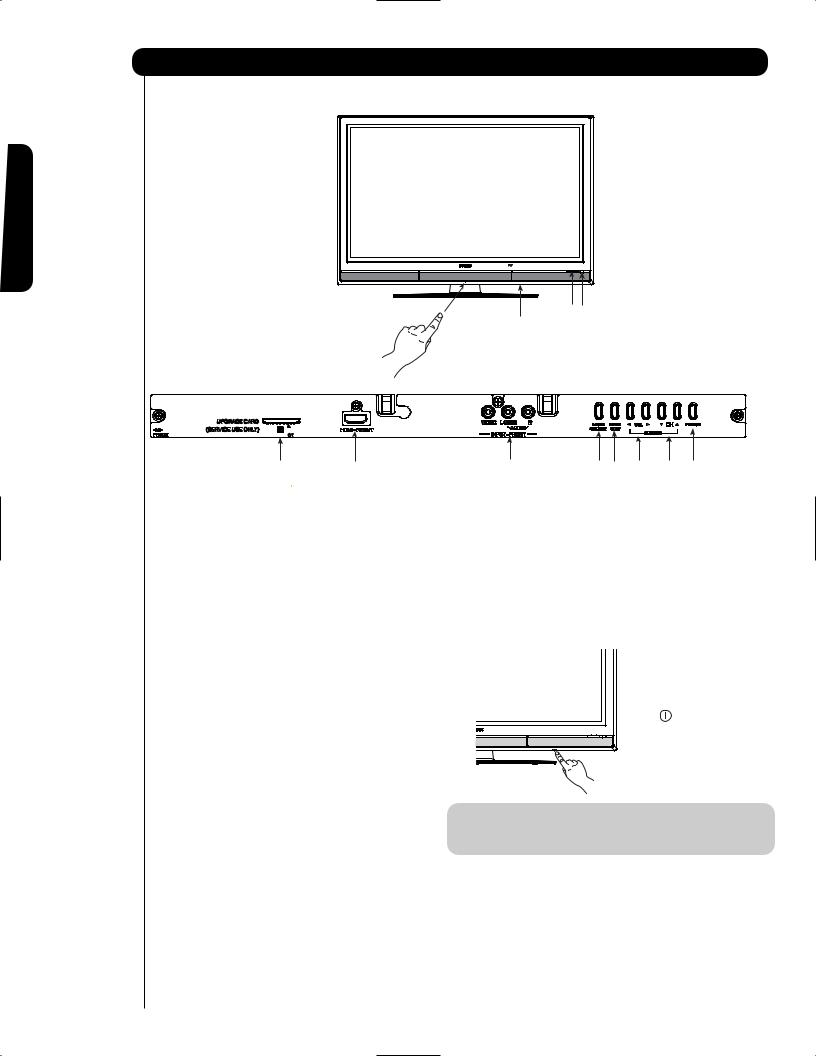
Front Panel Controls
FRONT VIEW
First time use
PUSH TO OPEN CONTROL DOOR
|
|
|
FRONT PANEL CONTROLS |
UPGRADE CARD |
|
|
|
(SERVICE USE ONLY) |
|
|
|
PUSH EJECT |
|
|
|
|
|
|
|
|
FRONT POWER button |
POWER button |
|
Press this button to turn the Plasma Television |
Television MAIN POWER button |
|
ON/OFF. It can also be turned ON/OFF by remote |
This power button is for the complete system, and |
|
control. The “MAIN POWER” button must be at |
must be turned ON/OFF manually. It is |
|
stand-by mode. |
recommended to leave the “MAIN POWER” to ON |
|
|
condition (lights red) for stand-by mode. |
|
MENU/SELECT button |
|
|
This button allows you to enter the MENU, making |
The Main Power |
|
it possible to set TV features to your preference |
button is located |
|
without using the remote. This button also serves |
on the broadside |
|
as the SELECT button when in MENU mode. |
bottom, under the |
|
|
mark " ". |
HDMI-FRONT
Use the front HDMI input for extrenal devices such as Set-Top-Boxes or DVD players equipped with an HDMI output connection (see page 15 for reference).
INPUT/EXIT button
|
Press this button to access the INPUT menu. |
NOTE: When the “MAIN POWER” button is set to |
|
|
|
|
Press again to exit the MENU mode. |
OFF or the TV is unplugged, the clock will |
|
|
|
|
|
stop and may eventually reset itself. |
|
|
|
|
CHANNEL selector |
|
|
|
|
|
Press these buttons until the desired channel |
Upgrade Card |
|
|
|
|
appears in the top right corner of the TV screen. |
This card slot is for future software upgrades. |
|
|
|
|
These buttons also serve as the cursor down ( ) |
Hitachi will notify you if a software upgrade is |
|
|
|
|
and up ( ) buttons when in MENU mode. |
required for your TV. In order to receive written |
|
|
|
|
|
notification, please complete and return your |
|
|
|
|
VOLUME level |
warranty card. |
|
|
|
|
Press these buttons to adjust the sound level. The |
|
|
|
|
|
volume level will be displayed on the TV screen. |
|
|
|
|
|
These buttons also serve as the cursor left ( ) and |
|
|
|
|
|
|
|
|
|
|
12 |
right ( ) buttons when in MENU mode. |
|
|
|
|
|
|
|
|
||
|
|
|
|
|
|
|
|
|
|
|
|
|
|
|
|
|
|
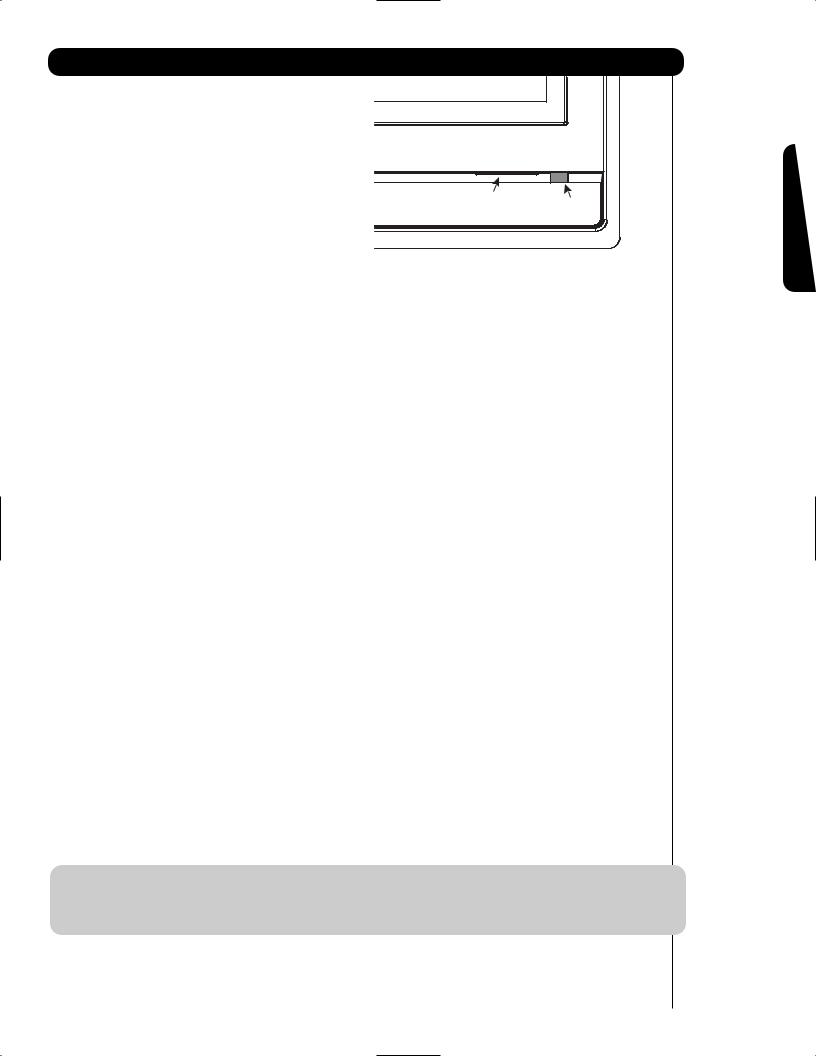
Front Panel Controls
POWER light indicator
To turn the TV ON, press the main power switch located on the lower right side of the TV. A red stand-by indicator lamp located on the lower right corner of the front bezel will illuminate. The Plasma TV is now ready for remote ON/OFF operation.
Indicating Lamp |
R/C sensor |
|
Indicating Lamp |
Power Status |
Operating |
|
|
|
|
|
Off |
OFF. |
When the main power switch is set to Off. |
|
|
|
|
|
Lights |
OFF. |
When the main power switch on the TV is ON. |
|
Red |
(Stand-by) |
||
|
|||
|
|
|
|
Lights |
On |
TV MAIN POWER is ON ; picture is shown. |
|
Blue |
|||
|
|
||
|
|
|
|
Lights |
Off |
TV MAIN POWER is ON with no signal input |
|
Orange |
(Power Saving) |
except antenna (no sync. signal). |
|
|
|
|
|
Blinking |
On |
When TV receives the IR signal from R/C. |
|
Blue |
|||
|
|
||
|
|
|
REMOTE CONTROL sensor
Point your remote at this area when selecting channels, adjusting volume, etc.
INPUT-FRONT JACKS
INPUT-FRONT provide composite Video jacks for
connecting equipment with this capability, such as a DVD player or Camcorders.
NOTES: 1. Your HITACHI Plasma TV will appear to be turned OFF (lights orange) if there is no video input when INPUT : 1, 2, 3, Front or HDMI : 1, 2, Front is selected. Check the Power Light to make sure the TV is turned off or in Stand-by mode (lights red) when not in use.
2.Remote Control can not turn ON/OFF the “MAIN POWER” of the TV.
use time First
13
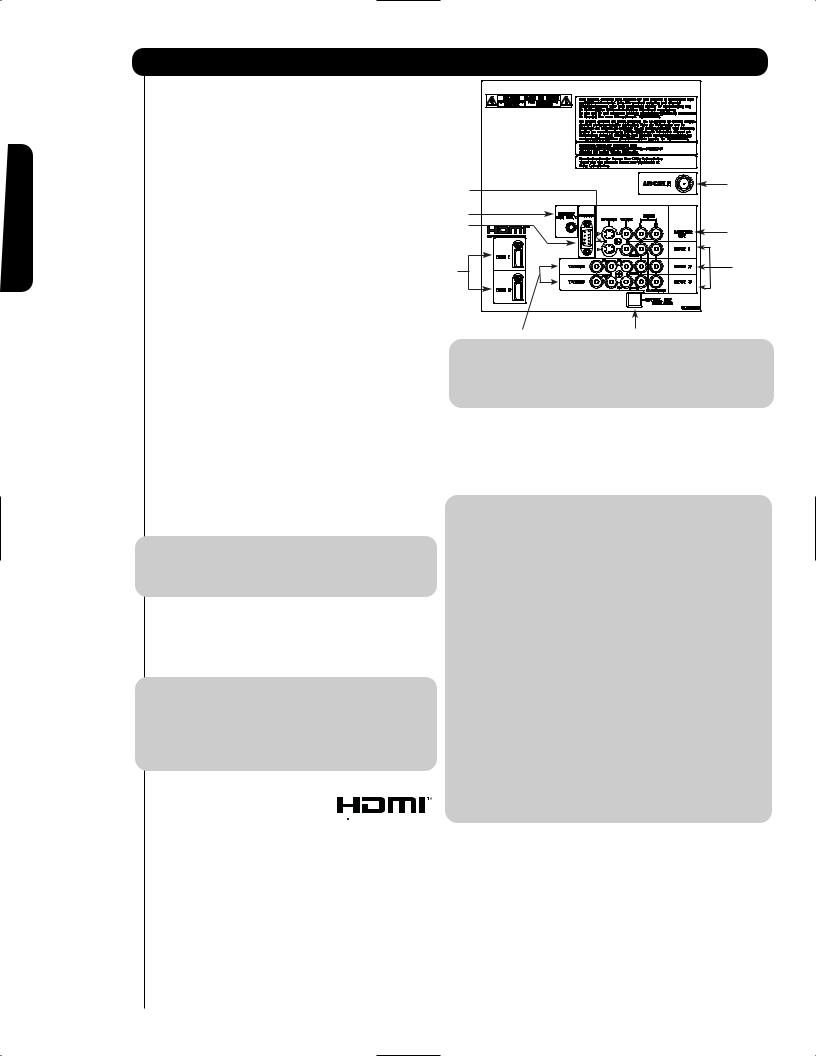
First time use
Rear Panel Connections
Antenna Input
To switch between Cable and Air input, go to the Channel Manager option to change the signal source CABLE or AIR.
Audio/Video Inputs 1, 2 and 3
By using the INPUTS button, the CURSOR PAD ( and ), and the SELECT button or CURSOR PADof the remote control, you can select each video source. Use the audio and video inputs to connect external devices, such as VCRs, camcorders, laserdisc players, DVD players etc. (if you have mono sound, insert the audio cable into the left audio jack).
MONITOR OUT & AUDIO OUT
These jacks provide fixed audio and video signals (CABLE/AIR or INPUTS ) which are used for recording. Use the S-VIDEO output for high quality video output. Component signal to Input 2 and 3, and HDMI inputs will not have monitor output.
Optical Out (Digital Audio)
This jack provides Digital Audio Output for your audio device that is Dolby® Digital and PCM compatible, such as an audio amplifier.
NOTE: *Manufactured under license from Dolby Laboratories. “Dolby” and the double-D symbol are trademarks of Dolby Laboratories.
S-VIDEO Input 1
Input 1 provide S-VIDEO (Super Video) jacks for connecting equipment with S-VIDEO output capability.
NOTE: 1. You may use VIDEO or S-VIDEO inputs to connect to INPUT 1 , but only one of these inputs may be used at a time.
2. S-VIDEO output may be used for recording, only when the input is of S-VIDEO type.
HDMI 1, 2 (High Definition Multimedia
Interface)
ABOUT HDMI – HDMI is the 





























 next-generation all digital interface for consumer electronics. HDMI enables the secure distribution of uncompressed high-definition video and multichannel audio in a single cable. Because digital television (DTV) signals remain in digital format, HDMI assures that pristine high-definition images retain the highest video quality from the source all the way to your television screen.
next-generation all digital interface for consumer electronics. HDMI enables the secure distribution of uncompressed high-definition video and multichannel audio in a single cable. Because digital television (DTV) signals remain in digital format, HDMI assures that pristine high-definition images retain the highest video quality from the source all the way to your television screen.
Use the HDMI input for your external devices such as Set-Top-Boxes or DVD players equipped with an HDMI output connection.
|
HDMI, the HDMI logo and High-Definition |
14 |
Multimedia Interface are trademarks or registered |
|
|
|
|
|
|
|
|
|
|
|
|
|
|
NOTE: 1. The HDMI input is not intended for use with personal computers.
2.Only DTV formats such as 1080p, 1080i, 720p, 480i and 480p are available for HDMI input.
Component: Y-PBPR Inputs
INPUTS 2 and 3 provide Y-PBPR jacks for connecting equipment with this capability, such as a DVD player or Set Top Box. You may use composite video signal for both inputs.
NOTE: 1. Do not connect composite VIDEO and S-VIDEO to INPUT 1 at the same time. S-VIDEO has priority over VIDEO input.
2.Your component outputs may be labeled Y, B-Y, and R-Y. In this case, connect the components B-Y output to the TV’s PB input and the components R-Y output to the TV’s PR input.
3.Your component outputs may be labeled Y-CBCR. In this case, connect the component CB output to the TV’s PB input and the component CR output to the TV’s PR input.
4.It may be necessary to adjust TINT to obtain optimum picture quality when using the Y-PBPR inputs (see page 34).
5.To ensure no copyright infringement, the MONITOR OUT output will be abnormal, when using the Y-PBPR jacks and HDMI Input.
6.INPUT 2 , and 3 (Y/VIDEO) can be used for composite video and component video input.
For Special AV control use only.
For Factory use only.
trademarks of HDMI Licensing LLC.
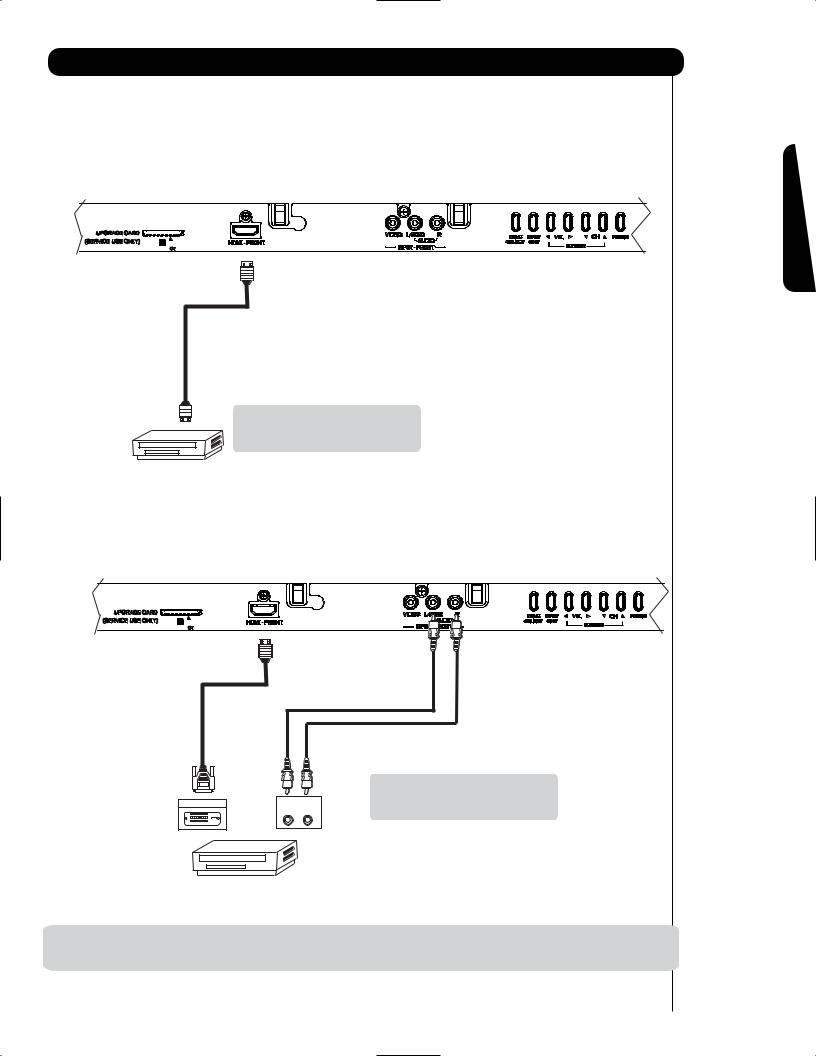
Connecting External Video Sources
The FRONT panel jacks are provided as a convenience to allow you to easily connect HDMI or DVI signals from a DVD, Set Top Box , Video Game as shown in the following examples (When connecting DVI signal it will need to connect the audio output into the Front Audio Input jacks) :
A)Connecting HDMI signal.
FRONT INPUT PANEL
UPGRADE CARD 
(SERVICE USE ONLY)
PUSH EJECT
Note : Special device cables will be according to the own device specifications.
HDMI DIGITAL
OUTPUT CAPABILITY
DVD , Set Top Box,
Video Game Console.
B) Connecting DVI signal.
FRONT INPUT PANEL
UPGRADE CARD 
(SERVICE USE ONLY)
PUSH EJECT
DVI to HDMI |
|
|
|
Cable |
|
|
|
|
|
Note : Special device cables will be |
|
DIGITAL OUTPUT |
OUTPUT |
according to the own device |
|
specifications. |
|||
|
L R |
Back of
HDTV Set-Top-Box or
DVD Player
DVI DIGITAL
OUTPUT CAPABILITY
DVD , Set Top Box,
Video Game Console.
NOTE: 1. Completely insert connection cord plugs when connecting to front panel jacks. If you do not, the played back picture may be abnormal.
use time First
15
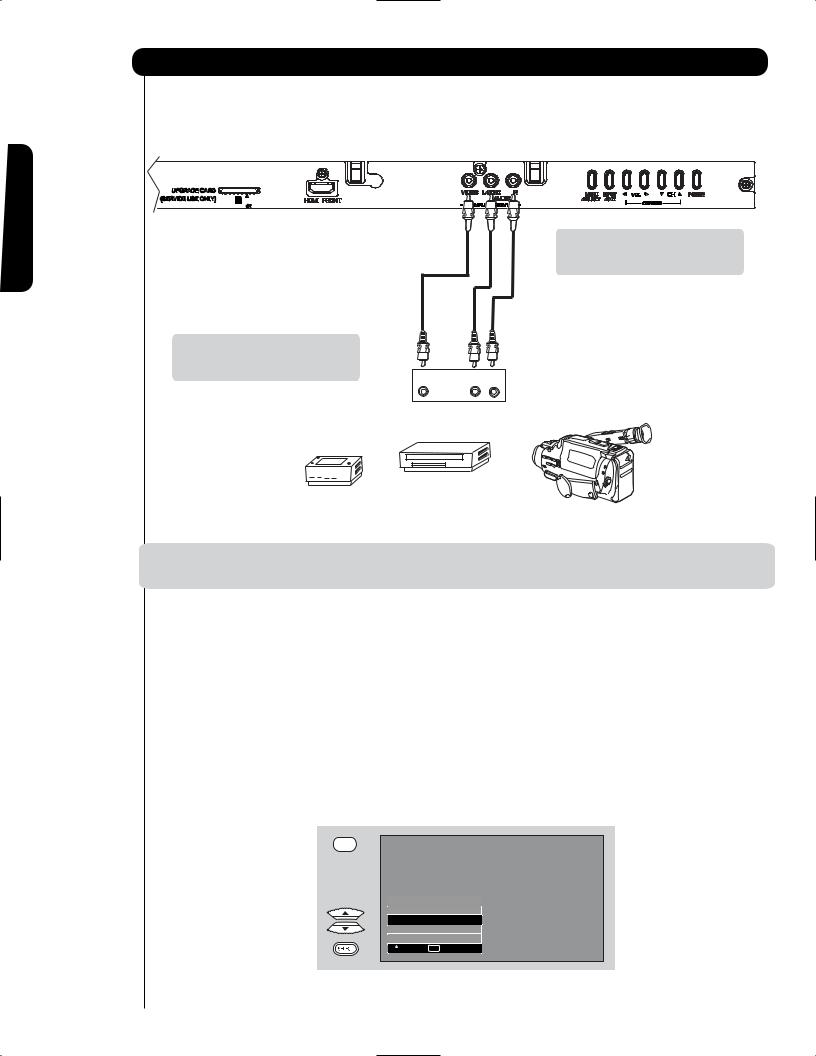
First time use
Connecting External Video Sources
The FRONT panel jacks are provided as a convenience to allow you to easily connect a camcorder , DVD, Video Game and a VCR as shown in the following examples:
FRONT INPUT PANEL
UPGRADE CARD |
|
(SERVICE USE ONLY) |
- |
|
PUSH EJECT |
Note : Special device cables will be |
|
according to the own device |
|
specifications. |
OUTPUT |
Video |
L R |
COMPOSITE VIDEO
OUTPUT CAPABILITY
Video Game DVD , Video Game
Console.
Note : For Monoaural devices, please
connect Audio signal cable into L/Mono input jack .
Video Camera
NOTE:1. Completely insert connection cord plugs when connecting to front panel jacks. If you do not, the played back picture may be abnormal.
The exact arrangement you use to connect the VCR, camcorder, laserdisc player, DVD player, or HDTV Set Top Box to your Plasma TV is dependent on the model and features of each component. Check the owner’s manual of each component for the location of video and audio inputs and outputs.
The following connection diagrams are offered as suggestions. However, you may need to modify them to accommodate your particular assortment of components and features. For best performance, video and audio cables should be made from coaxial shielded wire.
Before Operating External Video Source
Connect an external source to one of the INPUT terminals, then press the INPUTS button to show the
INPUTS menu. Use the CURSOR PAD ( and ) to select the Input of your choice. Then press the SELECT button or the CURSOR PAD to confirm your choice (see page 26).
INPUTS
HDMI 2
HDMI-Front
Air /Cable
Input 1
Input 2
 Move SEL Sel.
Move SEL Sel.
16
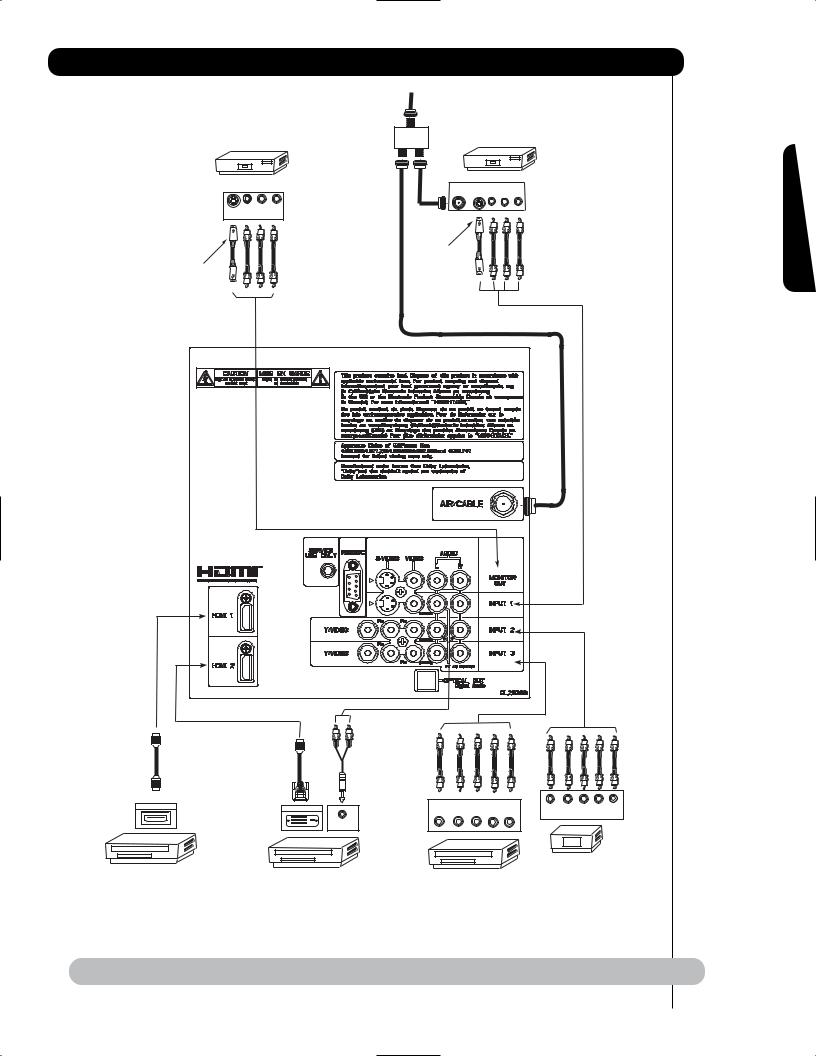
Rear Panel Connections
Outside Antenna or
Cable TV coaxial cable 
2-Way signal splitter 
VCR #1
VCR #2 |
OUTPUT |
|
ANT |
||
S-VIDEO V L R |
||
IN |
||
S-VIDEO V L R |
|
|
INPUT |
|
Optional
Optional
HDMI |
DVI |
|
to |
||
to |
||
HDMI |
||
HDMI |
||
|
HDMI OUTPUT |
DIGITAL OUTPUT |
AUDIO OUT
HDMI DIGITAL |
DIGITAL |
|
OUTPUT CAPABILITY |
||
OUTPUT CAPABILITY |
||
|
NOTE: Cables are optional, except when specified.
OUTPUT |
Y |
P B P R L R |
|
Y PB/CB PR/CR L R |
|||
|
OUTPUT |
HDTV Set-Top Box
DVD Player
use time First
17

|
Tips on Rear Panel Connections |
|
|
• |
S-VIDEO, Y-PBPR, or HDMI connections are provided for high performance laserdisc players, VCRs etc. that |
|
|
have this feature. Use these connections in place of the standard video connection if your device has this |
|
|
feature. |
use |
• If your device has only one audio output (mono sound), connect it to the left audio jack on (L/(MONO)) the |
|
|
Rear Panel. |
|
|
|
|
time |
• |
Refer to the operating guide of your other electronic equipment for additional information on connecting |
|
your hook-up cables. |
|
|
|
|
First |
• A single VCR can be used for VCR #1 and VCR #2, but note that a VCR cannot record its own video or line |
|
|
output (INPUT: 1 in the example on page 17). Refer to your VCR operating guide for more information on |
|
|
|
|
|
|
line input-output connections. |
|
• Connect only 1 component (VCR, DVD player, camcorder, etc.) to each input jack. |
|
|
• COMPONENT: Y-PBPR (Input 2 & 3) connections are provided for high performance components, such as |
|
|
|
DVD players and set-top-boxes. Use these connections in place of the standard video connection if your |
|
|
device has this feature. |
|
• |
Your component outputs may be labeled Y, B-Y, and R-Y. In this case, connect the components B-Y |
|
|
output to the TV’s PB input and the components R-Y output to the TV’s PR input. |
|
• |
Your component outputs may be labeled Y-CBCR. In this case, connect the components CB output to the |
|
|
TV’s PB input and the components CR output to the TV’s PR input. |
|
• It may be necessary to adjust TINT to obtain optimum picture quality when using the Y-PBPR inputs. (See |
|
|
|
page 34). |
|
• To ensure no copyright infringement, the MONITOR OUT output will be abnormal, when using the Y-PBPR and |
|
|
|
HDMI input jacks. |
|
• Input HDMI 1, HDMI 2 or HDMI FRONT can accept HDMI signal. |
|
|
• S-VIDEO monitor output may be used for recording only when the input is of S-VIDEO type. |
|
|
• When using a HDMI input from a Set-Top-Box, it is recommended to use a 1080p, 1080i or 720p input signal. |
|
|
• When HDMI input a 1080p signal, it is recommended that the length of the cable should be less than 5 meters. |
|
INSTALLATION RECOMMENDATION:
1.Video signals fed through a VCR may be affected by copyright protection systems and the picture will be distorted on the television.
2.Connecting the television directly to the Audio /Video output of a Set-Top-Box will assure a more normal picture.
18
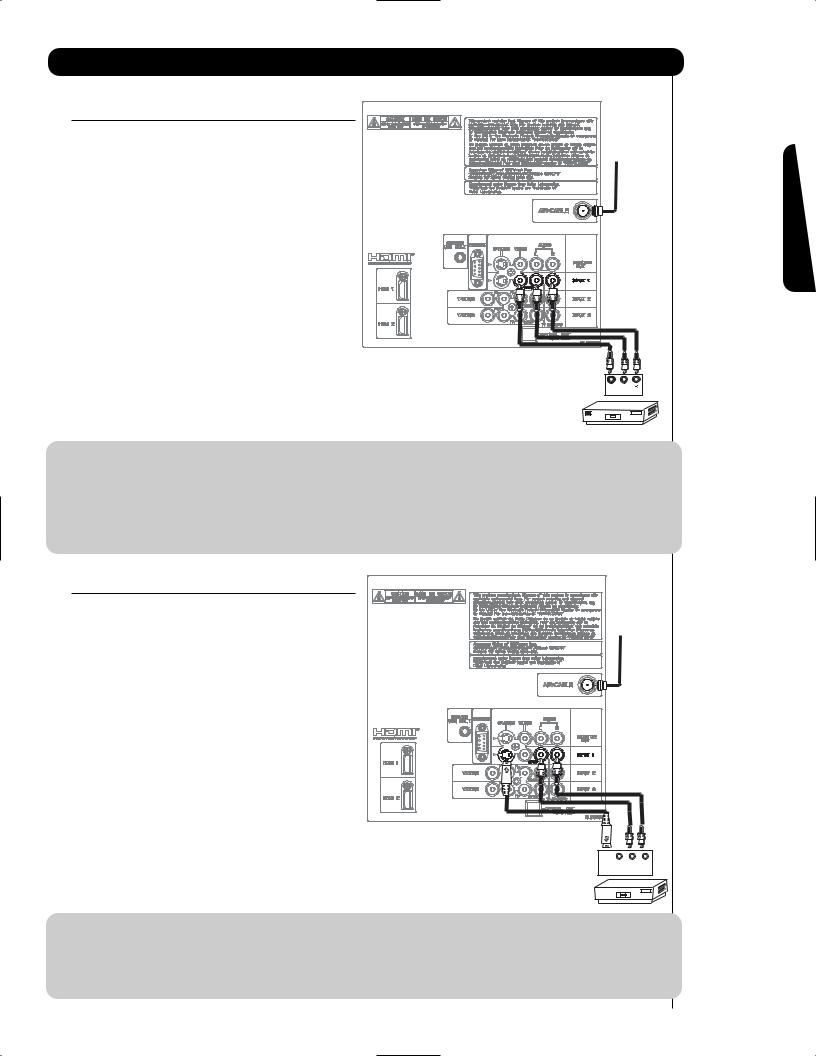
Connecting External Video Sources
CONNECTING A VIDEO AND STEREO AUDIO
SOURCE TO INPUT1 ~ INPUT-FRONT
1.Connect the cable from the VIDEO OUT of the VCR or the laserdisc player to the INPUT (VIDEO) jack, as shown on the Rear Panel to the right.
2.Connect the cable from the AUDIO OUT R of the VCR or the laserdisc player to the INPUT (AUDIO/R) jack.
3. Connect the cable from the AUDIO OUT L of the VCR or the laserdisc player to the INPUT (AUDIO/L) jack.
4.Press the INPUTS button, then select INPUT 1 2,3 or Front from the INPUTS menu to view the program from the VCR or laserdisc player.
5.Select CABLE or AIR from the INPUTS menu to return to the last channel tuned.
Cable or
Air signal
Back of |
Video |
|
VCR |
||
OUTPUT |
||
|
VCR
NOTE: 1. Completely insert the connection cord plugs when connecting to rear panel jacks. The picture and sound that is played back will be abnormal if the connection is loose.
2.A single VCR can be used for VCR #1 and VCR #2 (see page 17) but note that a VCR cannot record its own video or line output. Refer to your VCR operating guide for more information on line inputoutput connections.
3.When INPUT 2 or 3 are used, it is necessary to connect the video output of the device to the Y/VIDEO input jack of the TV .
CONNECTING AN S-VIDEO AND STEREO AUDIO SOURCE TO INPUT 1
1.Connect the cable from the S-VIDEO OUT of the S-VHS VCR or the laserdisc player to the INPUT (S-VIDEO) jack, as shown on the Rear Panel to the right.
2.Connect the cable from the AUDIO OUT R of the VCR or the laserdisc player to the INPUT (AUDIO/R) jack.
3.Connect the cable from the AUDIO OUT L of the VCR or the laserdisc player to the INPUT (AUDIO/L) jack.
4.Press the INPUTS button, then select INPUT 1 from the INPUTS menu to view the program from the VCR or laserdisc player.
5.Select CABLE or AIR from the INPUTS menu to return to the last channel tuned.
Cable or
Air signal
Back of VCR or 



Laserdisc Player S-VIDEO Video L R
OUTPUT
VCR or Laserdisc Player
NOTE: 1. Completely insert the connection cord plugs when connecting to rear panel jacks. The picture and sound that is played back will be abnormal if the connection is loose.
2.A single VCR can be used for VCR #1 and VCR #2 (see page 17), but note that a VCR cannot record its own video or line output. Refer to your VCR operating guide for more information on line inputoutput connections.
use time First
19

First time use
Connecting External Video Sources
CONNECTING A COMPONENT SOURCE WITH HDMI OR DVI CAPABILITY TO HDMI 1, HDMI 2 OR HDMI FRONT
1. Connect the HDMI or DVI to HDMI connection
cable from the output of the HDTV set top box or DVD player to the HDMI input as shown
on the Rear panel below.
2.With DVI output, connect the cable from the AUDIO OUT R of the HDTV set top box or DVD player to the INPUT (AUDIO/R) jack as shown on the Rear Panel below.
3.With DVI output, connect the cable from the AUDIO OUT L of the HDTV set top box or DVD player to the INPUT (AUDIO/L) jack as shown on the Rear Panel below.
4.Press the INPUTS button, then select HDMI 1, 2 or FRONT to view the program from the HDTV SET TOP BOX or DVD player.
5.Select CABLE or AIR from the INPUTS menu to return to the last channel viewed.
HDMI input
NOTE: 1. Completely insert the connection cord plugs when connecting to rear panel jacks. The picture and sound that is played back will be abnormal if the connection is loose.
2.The HDMI input on HDMI 1 , 2 and FRONT contains the copy protection system called High-bandwidth Digital Content Protection (HDCP). HDCP is a cryptographic system
that encrypts video signals when using HDMI connections to prevent illegal copying of video contents.
3.HDMI is not a “NETWORK” technology. It establishes a one-way point-to-point connection for delivery of uncompressed video to a display.
4.The connected digital output device
controls the HDMI interface so proper set-up of device user settings determines final video appearance.
5.When using a DVI to HDMI cable, connect the Audio Out L and R cables at the same INPUT (1 , 2 or Front) as your HDMI INPUT(1 , 2 or Front). (For FRONT INPUT see page 15 for reference).
CABLE or
Air signal
HDTV Set-Top-Box or
DVD Player
DIGITAL OUTPUT Back of
HDTV Set-Top-Box or
DVD Player
HDMI
Cable
or
DVI to HDMI Input
Back of HDTV Set-Top-Box or DVD Player
HDTV Set-Top-Box or
DVD Player
OUTPUT
DIGITAL OUTPUT
L R
DVI to HDMI
Cable
or
CABLE or
Air signal


 or
or
20
